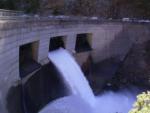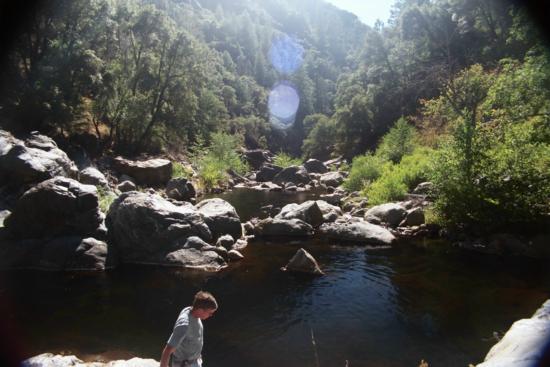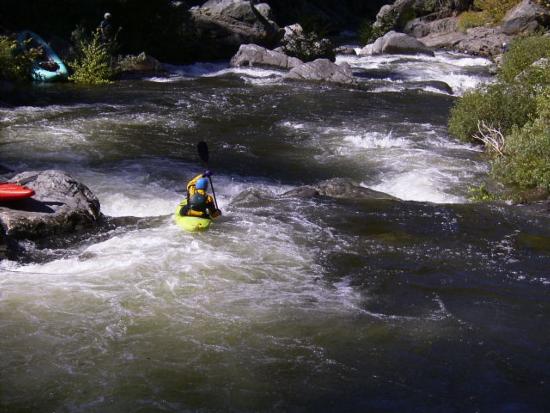Hydropower-related pulsed-flow impacts on stream fishes
-
IssueThe societal benefits of hydropower systems (e.g., relatively clean electrical power, water supply, flood control, and recreation) come with a cost to native stream fishes. Until now, the specific effects of the associated pulsed-flow releases on stream fishes have not been reviewed in detail, or synthesized in a conceptual model that would allow managers to predict and mitigate the negative effects.

-
Objectives
We had four main objectives: 1) Review the international literature for the effects of pulsed flows on stream fishes; 2) Develop a conceptual model to predict the effects of different types of pulsed flow; 3) Identify gaps in knowledge; and, 4) Identify research activities to address these gaps.
-
Research Activities
We reviewed and synthesized the literature on hydropower-related pulsed flows to guide resource managers in addressing significant impacts while avoiding unnecessary curtailment of hydropower operations.
-
Results
Dams may release pulsed flows in response to needs for peaking power, recreational flows, reservoir storage adjustment for flood control, or to mimic natural peaks in the hydrograph. Depending on timing, frequency, duration, and magnitude, pulsed flows can have adverse or beneficial short and long-term effects on resident or migratory stream fishes. Adverse effects include direct impacts to fish populations due to 1. stranding of fishes along the changing channel margins, 2. downstream displacement of fishes, and 3. reduced spawning and rearing success due to redd/nest dewatering and untimely or obstructed migration. Beneficial effects include: 1. maintenance of habitat for spawning and rearing, and 2. biological cues to trigger spawning, hatching, and migration. We developed a basic conceptual model to predict the effects of different types of pulsed flow, identified gaps in knowledge, and identified research activities to address these gaps.
-
Outcomes and Impacts
Our work indicates that there is a clear need for a quantitative framework incorporating mathematical representations of field and laboratory results on flow, temperature, habitat structure, fish life stages by season, fish population dynamics, and multiple fish species, which can be used to predict outcomes and design mitigation strategies in other regulated streams experiencing pulsed flows. The results of this project have been published as a report to the California Energy Commission, in a peer-review journal, and will be presented at the national annual meeting of the American Fisheries Society. This information may now guide current licensing endeavors and encourage new research to allow a more thorough synthesis of pulsed flow effects. Ultimately, this will allow resource managers to prevent or mitigate significant negative impacts of pulsed flows while avoiding unnecessary curtailment of hydropower operations due to a lack of knowledge.
-
Photos
 View of pool on Silver Creek, CA during summer baseflow, Aug. 2004 (same vantage as photo below). Photo by Lisa Thompson.
View of pool on Silver Creek, CA during summer baseflow, Aug. 2004 (same vantage as photo below). Photo by Lisa Thompson. Kayaker runs a drop on Silver Creek, CA during pulsed flow on Sept. 15, 2004 (same vantage as photo above). Photo by Lisa Thompson.
Kayaker runs a drop on Silver Creek, CA during pulsed flow on Sept. 15, 2004 (same vantage as photo above). Photo by Lisa Thompson. -
Supporting Information
Young P, JJ Cech, LC Thompson. 2011. Hydropower-related pulsed-flow impacts on stream fishes: A brief review, conceptual model, knowledge gaps, and research needs. Reviews in Fish Biology and Fisheries. DOI: 10.1007/s11160-011-9211-0 Download Request Reprint
Young PS, Conklin DE, O’Hagan J, Canaday J, Cox C, Cech JJ Jr, Sih A, LC Thompson. 2007. Hydropower-related pulsed flow impacts on stream fishes, amphibians, and macroinvertebrates. Prepared for California Energy Commission-Public Interest Energy Research Program, Sacramento, California. December 2007. 50 p. Request Reprint
-
Acknowledgements
This project was funded by the California Energy Commission.
-
For more information contact
Dr. Lisa C. Thompson
Wildlife, Fish, & Conservation Biology Department
University of California, DavisEmail: lcthompson@ucdavis.edu
Phone: (530) 754-5732



